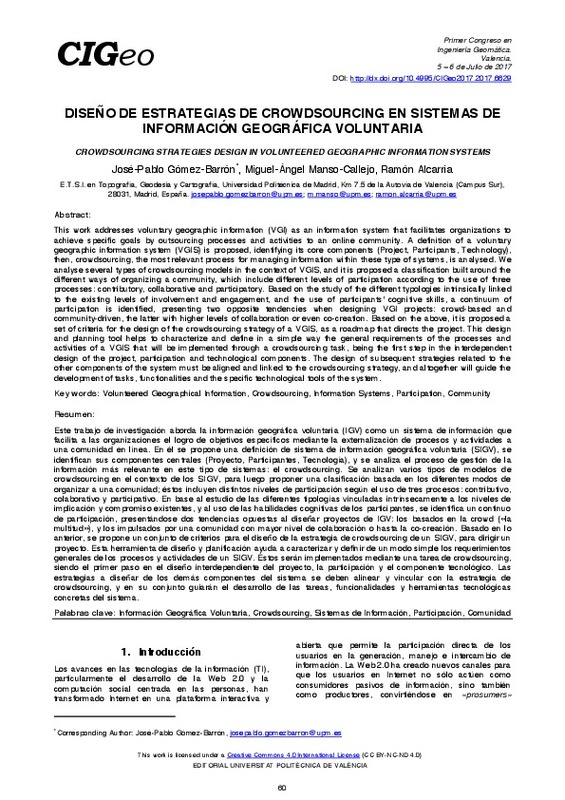|
Resumen:
|
[EN] This work addresses voluntary geographic information (VGI) as an information system that facilitates organizations to
achieve specific goals by outsourcing processes and activities to an online community. A definition ...[+]
[EN] This work addresses voluntary geographic information (VGI) as an information system that facilitates organizations to
achieve specific goals by outsourcing processes and activities to an online community. A definition of a voluntary
geographic information system (VGIS) is proposed, identifying its core components (Project, Participants, Technology),
then, crowdsourcing, the most relevant process for managing information within these type of systems, is analysed. We
analyse several types of crowdsourcing models in the context of VGIS, and it is proposed a classification built around the
different ways of organizing a community, which include different levels of participation according to the use of three
processes: contributory, collaborative and participatory. Based on the study of the different typologies intrinsically linked
to the existing levels of involvement and engagement, and the use of participants' cognitive skills, a continuum of
participation is identified, presenting two opposite tendencies when designing VGI projects: crowd-based and
community-driven, the latter with higher levels of collaboration or even co-creation. Based on the above, it is proposed a
set of criteria for the design of the crowdsourcing strategy of a VGIS, as a roadmap that directs the project. This design
and planning tool helps to characterize and define in a simple way the general requirements of the processes and
activities of a VGIS that will be implemented through a crowdsourcing task, being the first step in the interdependent
design of the project, participation and technological components. The design of subsequent strategies related to the
other components of the system must be aligned and linked to the crowdsourcing strategy, and altogether will guide the
development of tasks, functionalities and the specific technological tools of the system.
[-]
[ES] Este trabajo de investigación aborda la información geográfica voluntaria (IGV) como un sistema de información que
facilita a las organizaciones el logro de objetivos específicos mediante la externalización de procesos ...[+]
[ES] Este trabajo de investigación aborda la información geográfica voluntaria (IGV) como un sistema de información que
facilita a las organizaciones el logro de objetivos específicos mediante la externalización de procesos y actividades a
una comunidad en línea. En él se propone una definición de sistema de información geográfica voluntaria (SIGV), se
identifican sus componentes centrales (Proyecto, Participantes, Tecnología), y se analiza el proceso de gestión de la
información más relevante en este tipo de sistemas: el crowdsourcing. Se analizan varios tipos de modelos de
crowdsourcing en el contexto de los SIGV, para luego proponer una clasificación basada en los diferentes modos de
organizar a una comunidad; éstos incluyen distintos niveles de participación según el uso de tres procesos: contributivo,
colaborativo y participativo. En base al estudio de las diferentes tipologías vinculadas intrínsecamente a los niveles de
implicación y compromiso existentes, y al uso de las habilidades cognitivas de los participantes, se identifica un continuo
de participación, presentándose dos tendencias opuestas al diseñar proyectos de IGV: los basados en la crowd («la
multitud»), y los impulsados por una comunidad con mayor nivel de colaboración o hasta la co-creación. Basado en lo
anterior, se propone un conjunto de criterios para el diseño de la estrategia de crowdsourcing de un SIGV, para dirigir un
proyecto. Esta herramienta de diseño y planificación ayuda a caracterizar y definir de un modo simple los requerimientos
generales de los procesos y actividades de un SIGV. Éstos serán implementados mediante una tarea de crowdsourcing,
siendo el primer paso en el diseño interdependiente del proyecto, la participación y el componente tecnológico. Las
estrategias a diseñar de los demás componentes del sistema se deben alinear y vincular con la estrategia de
crowdsourcing, y en su conjunto guiarán el desarrollo de las tareas, funcionalidades y herramientas tecnológicas
concretas del sistema.
[-]
|








